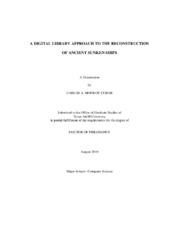| dc.description.abstract | Throughout the ages, countless shipwrecks have left behind a rich historical and
technological legacy. In this context, nautical archaeologists study the remains of these
boats and ships and the cultures that created and used them. Ship reconstruction can be
seen as an incomplete jigsaw reconstruction problem. Therefore, I hypothesize that a
computational approach based on digital libraries can enhance the reconstruction of a
composite object (ship) from fragmented, incomplete, and damaged pieces (timbers and
ship remains).
This dissertation describes a framework for enabling the integration of textual
and visual information pertaining to wooden vessels from sources in multiple languages.
Linking related pieces of information relies on query expansion and improving
relevance. This is accomplished with the implementation of an algorithm that derives
relationships from terms in a specialized glossary, combining them with properties and
concepts expressed in an ontology.
The main archaeological sources used in this dissertation are data generated from
a 17th-century Portuguese ship, the Pepper Wreck, complemented with information
obtained from other documented and studied shipwrecks. Shipbuilding treatises
spanning from the late 16th- to the 19th-centuries provide textual sources along with
various illustrations. Additional visual materials come from a repository of photographs
and drawings documenting numerous underwater excavations and surveys.
The ontology is based on a rich database of archaeological information compiled
by Mr. Richard Steffy. The original database was analyzed and transformed into an
ontological representation in RDF-OWL. Its creation followed an iterative methodology
which included numerous revisions by nautical archaeologists. Although this ontology
does not pretend to be a final version, it provides a robust conceptualization.
The proposed approach is evaluated by measuring the usefulness of the glossary
and the ontology. Evaluation results show improvements in query expansion across
languages based on Blind Relevance Feedback using the glossary as query expansion
collection. Similarly, contextualization was also improved by using the ontology for
categorizing query results. These results suggest that related external sources can be
exploited to better contextualize information in a particular domain. Given the
characteristics of the materials in nautical archaeology, the framework proposed in this
dissertation can be adapted and extended to other domains. | en |


